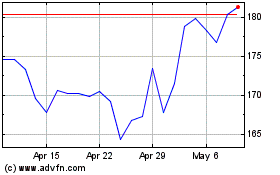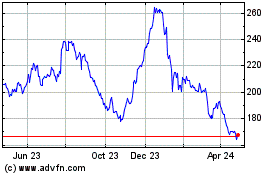Boeing Eyes Twin-Aisle Design For New Jet
March 07 2017 - 10:11PM
Dow Jones News
By Doug Cameron
SAN DIEGO -- Boeing Co. favors a twin-aisle design for a
proposed all-new commercial jet that likely wouldn't enter service
before 2024, a senior U.S. airline executive said Tuesday.
The plane maker hasn't previously disclosed design details of
what industry executives are already calling the 797, with a
seating capacity of more than 200 that would sit between its
workhorse 737 jets and the 787 Dreamliner.
New jetliners can cost more than $10 billion to develop, and the
decision whether to proceed with the plane will be a test for
Boeing Chief Executive Dennis Muilenburg as previous models
launched during his tenure have been derivatives of existing
aircraft.
Boeing has been marketing its concept of a new jet to airlines
and leasing companies, and many had expected it to be a
single-aisle plane that allows carriers to move passengers on and
off more quickly than a twin-aisle.
"We actually think it has a lot of merit," said Andrew Levy,
chief financial officer of United Continental Holdings Inc, a big
buyer of planes from Boeing and rival Airbus SE.
Mr. Levy, speaking at an industry conference, admitted he was
surprised at first by the favoring of a twin-aisle design, while
other industry executives said Boeing still had a lot of work to do
in completing the size, range and cost of any new jet.
Boeing said it was continuing to study what the plane would look
like, but said it would enter service in 2024 or 2025 if it opted
to press ahead.
Airbus chief salesman John Leahy said at the same event that it
had no immediate plans for a new aircraft type, but the European
company and Boeing have played a game of cat and mouse in recent
years with planes aimed at preventing the other from gaining a
larger share in a $120 billion a year jet market where they have
roughly even market shares.
Steven Udvar-Házy, chief executive of Air Lease Corp. and an
influential buyer of new planes, said Boeing would call it the 797,
adding that it reflected potential demand between its launch and a
likely production run stretching through 2060 when infrastructure
constraints affecting airports and airspace would start to
bite.
"There will be a growing need for an airplane in this category,"
Mr. Hazy said.
U.S. carriers like United and Delta Air Lines Inc. have been
looking for a replacement for the now-discontinued single-aisle
Boeing 757 jets still used on transcontinental routs and some
flights across the Atlantic. However, industry executives said
Boeing had to be mindful of demand elsewhere, notably from Asian
airlines.
"It has to have global applications," said Aengus Kelly, chief
executive of AerCap Holdings NV, a big aircraft lessor.
Mr. Kelly said Boeing was already in talks with engine makers
who'd have to fund development, and Mr. Hazy said he expected two
rival offerings to emerge, from General Electric Co. and a
combination of Rolls-Royce Holdings PLC and the Pratt & Whitney
unit of United Technologies Corp.
Write to Doug Cameron at doug.cameron@wsj.com
(END) Dow Jones Newswires
March 07, 2017 21:56 ET (02:56 GMT)
Copyright (c) 2017 Dow Jones & Company, Inc.
Boeing (NYSE:BA)
Historical Stock Chart
From Mar 2024 to Apr 2024

Boeing (NYSE:BA)
Historical Stock Chart
From Apr 2023 to Apr 2024
